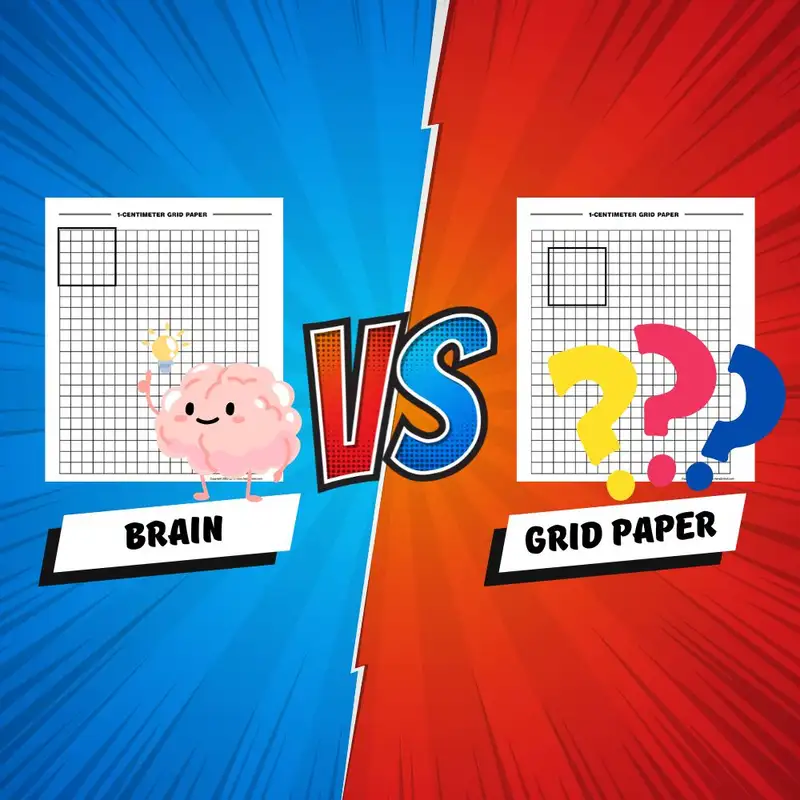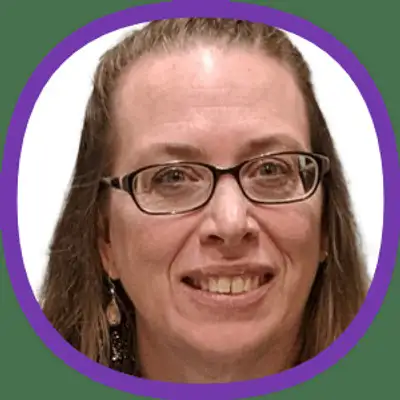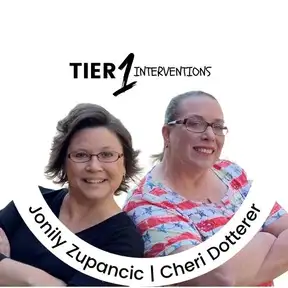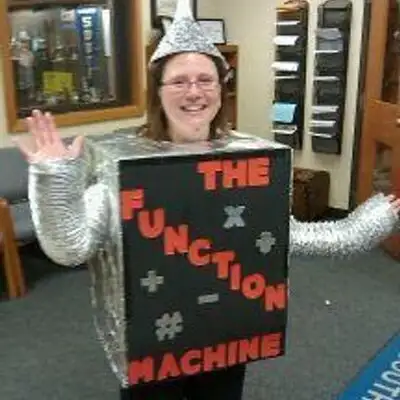
It’s NOT a 5x5! Why Grid Paper Trips Kids Up
Tier 1 Interventions Workshop: Geoboard Segment 4
===
[00:00:00] Hey everybody. Welcome to Tier One Interventions podcast. We are here today to talk about a geo board. Geo board is a very interesting device and when I first looked at it, I only saw it from an occupational therapy perspective where we were working on it with hand strengthening and such.
But I come to see how valuable it is as a math tool as well. Today we are going to blend the math and the occupational therapy together so that you can understand better what it looks like to have a geo board as a intervention in your classroom. Welcome Jonily to today's episode and everybody else who is with us.
It is great to have you here.
The final chunk is grid paper. So grid paper is different than dot [00:01:00] paper. So chunk number four, solution number four,
and I will just keep scrolling to centimeter grid paper or any grid or graph paper. Sarah had asked the question before, what comes first? The geo, the actual geo board or the dot paper? And it's really chicken and egg. It doesn't matter. However, if kids are struggling using graph paper or grid paper, so if I have a student that I say, okay, draw a five by five square, I'm gonna make this a little bit bigger just so we can see it.
Draw a five by five square. They don't trace the line if they're just like, oh, okay. And then they put a just total the lines are just irrelevant to them. And we see this a lot in the earlier grades, but even in the upper [00:02:00] grades, I will see a lot where kids, if I ask them to draw a five by five square, like sixth, seventh, and eighth graders, they start in the middle of the square.
So they'll go down like this, five squares, and then they'll go over and then they'll go up and then they'll go over here using grid paper. Okay. Now I use this as a teaching moment because I then use this square and I say to the whole class, let's find the area and perimeter of this, because this student and many other students will want the length to be five.
So four fives is 20, perimeter 20. And then they want this to be five by five. So area 25. That is not true. That is not true. Because if I cut out, see, and I brought [00:03:00] this ruler piece too for the, come on. Turn the radio on. See I did not break out in music today.
So just like with the dot paper where we cut our measuring tool, I have kids cut out a measuring tool with and with the graph paper. When we put this up here, look at this. What is the length of this side? The length of that side is actually four because I have, and if I move this, see, this is where we want kids.
Oh, don't move that. Come on. Oh, no. Yes. We want kids. If I line this up on the lines here, what we notice here is stop. Okay. [00:04:00] Collaborate and listen. What we notice here is this length is one, this length is one, this length is one. So this middle part here is three, and then we have a half and a half, and that's how we get the four.
So this is actually a four by four. So the area should be 16. And it is because I have this exact three by three. So this area right here is nine and then this. How much is that? That's a quarter of this square. So I have one fourth, two fourths, three-fourths. Oh, that's another one. So that makes 10. And then I have this half.
I actually have three sets of four halves, 12 halves, which is another six, hence a four by four has an area of [00:05:00] 16. Now here's my point, here's my point. If students are struggling with graph paper and grid paper, especially older students who have precision, see, this is an example of precision. Also, precision is being able to stay right in the middle of these lines, but it's not accurate for a five by five, what this student needs and what this student needs is to go to the grid paper.
Because if I say draw a five by five, they don't even think of starting here because there's no dot. Remember connecting the dots count by dot pages and books that I, you can't even do the like count by number. Dot to dots. I can't even find those anymore in stores. So that is a lost skill that kids [00:06:00] use to practice all the time.
However, it's pretty innate. You don't get that innateness with grid paper. But if you do dot paper instead of grid paper, kids are much more successful connecting dots than tracing the lines on the graph paper. So then what we can do is go from the dot paper to transition and say, and what I can do is I can do grid paper that I put dots on to show that the dots are actually at the vertices of those squares so kids can start to trace to understand how to use graph paper.
Another thing that might Oh, yep, go ahead. Before you go too much further than that. That also could be a vision issue with the kids that they, in their brain see it, that they are on the line where we see that it [00:07:00] is not, they could also have motor control. One thing that we can do instead of a traditional ruler is get one of these rulers that is in a triangular shape.
It has a, it's a foot long, like a regular ruler would be. It's the triangular shape. They can put their hand on the top as they're trying to trace. They're not down here like a regular ruler. Cans get too close together. Their hand is up above pushing down on the paper so that they have the control.
So if you get out the ruler to go with supporting them, creating the line, which as more a complication, believe me, you can also have some of these available. And they're available from through real OT solutions. They are called Alpha Triangles. I don't know of any other company that's making [00:08:00] a ruler with the triangular shape, but they will help the students as well.
But it could be literally be a vision tracking issue that they are not able to be on the line. Other thoughts?
So a point on
not being able to be on the lines shows up. Also, when we are having kids create XY axes on graph paper and they tend to not. Put it on the lines as well. We want kids to practice that and practice tracing. But one intervention is, instead of [00:09:00] giving the graph paper, give the kids dot paper to do the XY axis.
It's a great accommodation and intervention to use the dot paper instead of the graph paper. And use the dot paper and the graph paper because we want kids to eventually be able to do both. So here's the progression. Here's the progression. We create the, we use the physical geo board. So I think this sums up this whole series today.
We use the physical geo board to create the grid. The X and Y axis. Okay, so we have the physical geo board. So if this is my origin, the zero zero point, then this is my one one point. I can name these dots as ordered pairs, so I can physically do the XY [00:10:00] axis. The second step in the progression is to do dot paper XY axis, because it's much easier for students to connect the dots than it is for them to trace the line on the grid paper.
So using the dot paper first, then using dot, or I'm sorry, then using grid paper that also has the dots so that they start to make the connection of where the hidden dots are on the grid paper, so that the grid paper becomes a more.to dot. But then the other thing that is absolutely essential. Is having kids trace.
So even if I give them a grid paper with an X and Y axis, I'm gonna have them take a thick marker or a highlighter, and I'm gonna have them trace the x and y axis, even if I create it for them. Sometimes I wanna create it for them and have them trace. Sometimes [00:11:00] I wanna give them the dots and have them do it themselves, and then sometimes I want them to do it themselves on the graph paper.
So this is a gradual release of responsibility and it's going to e, it's going to help students become independent. Doing something themselves that they're currently unable to do. We do the physical, we do the dot paper, we do the dot and the grid with the lines with the tracing, and then just the tracing.
And then finally they're gonna start to be able to trace the lines on the graph Paper. Graph paper is absolutely essential with the secondary level. It's where we do most of our mathematics, whether we're doing geometry or algebra function shapes coordinate playing transformations. Graph paper is essential and too many kids at the secondary level struggle with graph paper.
So if I'm a secondary teacher, I'm gonna go back to the geo board to represent, then I'm gonna go to the dot paper, then I'm gonna go to the grid paper with the dots, and then just the grid paper [00:12:00] tracing on the grid paper and then just the grid paper. I'm gonna go through that cycle multiple times with all students because what's necessary for some is beneficial for all.
It's a different texture and it's a different sensory. So even students who aren't struggling with the graph paper and aren't struggling with the tool and aren't struggling with the math will still benefit from the progression of the concrete to the semi concrete to the abstract. And that my friends is section four.
Now we've come to the most abstract geo board, which is the grid paper. And how we can use these interventions and accommodations with the grid paper as well. A couple of things that we definitely want to create content for you, as I've been making my notes, is steepness of those diagonal lines. We wanna get into that not only the diagonal lines of squares and rectangles, but how many triangles can be created [00:13:00] inside any polygon so that we can understand angle measurements of regular polygons, and then lots to unpack with circles.
So we've got some other chunks that, that we're gonna want to bring content to you that is gonna be very much related to this. But that wraps up chunk number four, the grid paper and how we can progressively move from move struggling students from actual geo board to using graph paper and being highly functional with graph paper at the secondary level mathematically, Cheri.
For occupational therapists, utilizing those progressions that Jonily lined out. Will help us in our upgrading and downgrading of helping our students manipulate the different way, the different types of paper that we might present to them.
When we're looking at design copying, think about [00:14:00] how it is related to the geo board and the mathematics. It's looking at the de the design copying activity from a whole different perspective. 'cause I've never looked at it from that perspective before, but students struggle to do those complicated designs like that and they also will have trouble putting 'em on the physical geo board, which is why unstructured play with the geo board.
Dot paper, just unstructured, un facilitated play in just creating pictures, image images or abstracts is not only gonna benefit students non-academically and functionally, but it's going to benefit students mathematically because they are going to have a feel, a sense, a taste, a touch, a smell. It's gonna [00:15:00] engage all of their senses in how shape and images work mathematically so that then we can attend to precision when we're defining shape function using those tools, which students have a hard time mathematically and non mathematically.
. My mind is blown today oh my gosh. Oh my gosh. So many things. Give us a few takeaways, Natalie. I. I, one thing I wrote in the chat earlier I feel pretty good with my content, but then picking up these brain science things is like the next maybe big layer for me.
I am really excited to continue to learn more and just dive more into that and just seeing that connection, just knowing that the whiteboards work for my students, but then now being able to [00:16:00] pinpoint specific students and oh, okay, I'm seeing that more. And even was thinking further. Like one kid writes, oh, ridiculous.
This doesn't even look like handwriting on paper, but at the board I can read everything he writes. It's I never made that connection till today. I am like, okay, I'm just developing those different things. So I'm really excited to, and I think really important to learn more about the brain science and make those connections, but just even the connection to content and pizza problem and diagonals and like thinking about air parallelograms and area and all the things, I'm just, Ugh, I'm so excited.
What a great session. So excited. Awesome. Awesome. When he's so Natalie, so when he is working at his desk, not everybody has access to a lamp board, but you can use a binder. Just give him a binder and see if that works for him and just put his worksheet on the binder, a three ring binder, you have various sizes.
Just see if that works for him and see if just changing the height of his paper helps him. I will try that. [00:17:00] Great idea. The binding being away from him so that it's on the slant this way. Sometimes they collapse and you just stick stuff in it, to stop the collapse. But otherwise, they're inexpensive.
They probably have 'em in the building three, 3, 2, 1. You can vary the size based on what he needs, which creates that slant using a, yeah. Couple inch binder. Dang. Yes. That's so easy. Do you know how many schools throw away two inch binders. Collect those things and use 'em for slant. And you know what you can use 'em for too, is you can use them as a wedge on your seat.
So you know how kids they, you can turn them so that the wedge goes, so they angle, you put the three to the front, so they angle them back in the seat or the other way around. So they can angle either direction. All you do is put some, nice, tape on it, make it nice and sturdy because you may not have the money.
I don't have a [00:18:00] budget to do anything. Yeah. So you just make 'em nice and sturdy and you can make 'em as wedges for the chair and duct tape. Duct tape, duct tape cover. So it's almost the end of the year. There you go. It's thrown away. Binders, one inch, two inch, three inch binders. Collect all the old binder binders and cover them with duct tape to make them sturdy.
You've got slant surfaces and you've got sitting slanted surfaces or for the feet on the bottom, if you, if a kid can't, you gotta make sure their feet are stable on the floor, stack a couple, there you go. Rest, you get your feet touching the floor. Love it. Watch the duct tape and the writing surfaces.
Okay? Because they will, that will influence their writing because of the duct tape texture. One thing that you can do then, if you're gonna use it for a writing surface, is put construction paper over the duct tape. It will help buffer that texture a little bit. It won't solve it all, [00:19:00] but if you're writing on a construction paper, it's a better blot feel than even writing on the hard desk.
So that's another beautiful. Another alternative to kids who are struggling to even get the line lined up on the grid is put construction paper underneath the paper they're writing on. It creates a blotter and then they get a better feel and feedback into their hands as to where they're writing.
Oh my gosh, that is the most golden thing from today. Kids struggling with the tracing or the grid paper, put a piece of construction paper under the paper they're working on. That is so magnificently brilliant. That is my big takeaway.
I was so excited to get to this one. Sorry Krista, I just interrupted you because it's so OT and it's so math. This one was so much fun. Go ahead [00:20:00] Krista. It's okay. So this might be a little too much fourth wall, but I really enjoyed the facilitation of, I felt like it was the best integration that I have seen yet, like the toggle back and forth.
Okay. This is the math. These are the inter, like the interventions that you, when you see this happening, this is what this means. This is what you can do. From a gen ed perspective, I thought that this was the best I have been able to see how this all works together. Great feedback, Krista. I think it was the most, it was the most direct, interactive, yeah.
One of your tasks. Jonily. And I think there's so much more content that can come from it. And we thought about that, Krista, because we, I mean that, that is the one thing that we struggle with. We know that each of our expertise and [00:21:00] areas are. So connected, but how we articulate that to people is a huge struggle.
And we knew that going into this and I really appreciate your feedback on that because we know that it's clunky. We know that it's clunky and we ourselves have been working very strategically and very diligently on how to make that better connection so that we can offer the same presentation to multi audiences at the same time to the OT audience and the classroom teacher audience at the same time.
So that is really great feedback and I think definitely we are gonna continue to work on that as well. , thank you.
Episode Video
Creators and Guests


